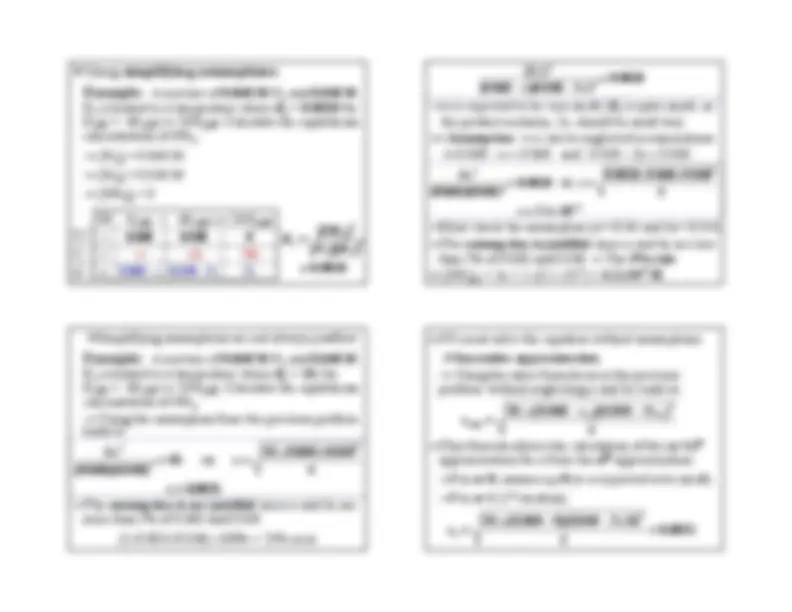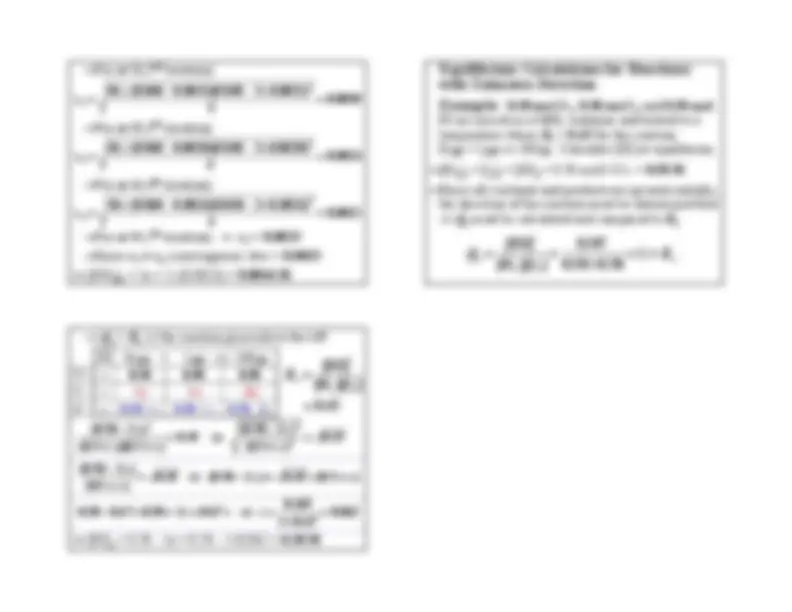




Study with the several resources on Docsity

Earn points by helping other students or get them with a premium plan


Prepare for your exams
Study with the several resources on Docsity

Earn points to download
Earn points by helping other students or get them with a premium plan
Community
Ask the community for help and clear up your study doubts
Discover the best universities in your country according to Docsity users
Free resources
Download our free guides on studying techniques, anxiety management strategies, and thesis advice from Docsity tutors
Information on solving equilibrium problems, including calculating kc values from measured equilibrium concentrations and vice versa, using equilibrium tables and the mass action expression. Examples are given for various reactions.
Typology: Study notes
1 / 4

This page cannot be seen from the preview
Don't miss anything!



K
c^
(or
K
) values from measured p
equilibrium concentrations (or pressures)
pressures) from
K
c^
(or
K
) values p
, [B]i
, [C]i
i^
, [B]e
, [C]e
e^
e^
i^
same is valid for B and C
x
(1 mol A/1 mol C) = -
x
(2 mol B/1 mol C) = -
x
[C]
i^
x
[B]
x
[A]
i^
-^
x
e
x
x
c
[C]
i
[B]
i
[A]
i
i
A
2B
↔
C
[ ]
2
i
i
i
2
c
The equation can be used to calculate
c^
if
x
is
known or to calculate
x
if
c^
is known
in the mass action expression to find
concentration are given, use an
ice
table to find
1.00 mol
of NH
3
is sealed in a
container and heated to 500 K. Calculate
c^
for
(g) 3
(g) 2
2
(g)
, if at equilibrium the
concentration of NH
3
is
i^
= 1.00 mol/1.00 L = 1.00 M
2
] i
2
] i
e^
e^
x
x
2
] e
x
2
] e
x
3
x
x
1.00 - 2
x
e
x
+x
x
c
0
0
i
(g) 3
(g) 2
(g) 2
[ ]
i + c = e
2
3
2 3
3 2
2
c
and all but one equilibrium concentrations are
given, substitute in the mass action expression for
to find the unknown concentration
are given, use an
ice
table to find the equilibrium concentrations
Example:
0.50 mol
of HI is sealed in a
reactor and heated to 700
C. Calculate the
equilibrium concentrations of all species if at 700
c^
for 2HI
(g)
(g) 2
(g) 2
i^
= 0.50 mol/2.0 L = 0.25 M
i^
2
] i
x
x
0.25 - 2
x
e
x
+x
x
c
0
0
i
(g)
2
(g)
(g) 2
[ ]
2
2
2
x
-
x
x
-
x
x
i + c = e
2
022 0
25 0
022 0
022 0
2
25 0
x... x. x -.
x
× − × = ⇒ = 029 0
297 0
1
0371 0
0371 0
297 0
... x. x. x
= + = ⇒ = +
(^22)
2 .
c
2
] e
e^
x
e^
x
¾
Using the
quadratic formula
Example:
0.50 mol
HI and
0.30 mol
2
are sealed
in a
reactor and heated to 700
C. Calculate
the equilibrium concentrations of all species if at 700
c^
for 2HI
(g)
(g) 2
2
(g)
i^
= 0.50 mol/2.0 L = 0.25 M
2
] i
= 0.30 mol/2.0 L = 0.15 M
i^
x
0.15 +
x
0.25 - 2
x
e
x
+x
x
c
0
i
(g)
(g) 2
(g) 2
[ ]
i + c = e
(^22)
2 .
c
022 0
4
2
25 0
2
25 0
15 0
022 0
)
2
25 (^0) (
)
15 (^0) (
2
2
2
2
.
x
x
.
.
x x.. x -.
x x
.^
=
×
×
−
⇒
=
0
00138 0
172 0
912 0
088 0
022 0
00138 0
15 0
4
022 0
25 0
4
022 0
25 0
022 0
15 0
2
2
2
2
2
2
=
−
−
=
× + × × − × = +
.
x
.
x
.
x. x.. x x.
x. x.... x x.
00768 0
912 0
2
)
00138 0 (-
912 0
4
172 0
172 0
2
4
2
2
2 1
.
.
.
.
.
.
x
a
ac
b
b
x
,
=
×
× × − + − =
−
±
2
] e
x
2
] e
x
e^
x
→
The (-) solution is meaningless
For
n=
nd
iteration)
(^0024). 0
4
)
(^0020). 0
3
040 0 )(
(^0020). 0
060 (^0) (
. 10
3
3
=
×
×
=
-
.
-
.
x
(^0020). 0
4
)
(^0031). 0
3
040 0 )(
(^0031). 0
060 (^0) (
. 10
3
2
=
×
×
=
-
.
-
.
x
For
n=
rd
iteration)
For
n=
th
iteration)
(^0023). 0
4
)
(^0024). 0
3
040 0 )(
(^0024). 0
060 (^0) (
. 10
3
4
=
×
×
=
-
.
-
.
x
For
n=
th
iteration)
x
5
Since
x
5
x
4
(convergence)
x
e^
x
Equilibrium Calculations for Reactionswith Unknown DirectionExample:
0.50 mol
0.50 mol
2
and
0.50 mol
HI are mixed in a
container and heated to a
temperature where
c^
for the reaction
(g) 2
2
(g)
(g)
. Calculate [HI] at equilibrium.
i^
2
]i
i^
= 0.50 mol/1.0 L =
Since all reactants and products are present initially,the direction of the reaction must be determined first ⇒
c^
must be calculated and compared to
c c
c^
2
2
2
2
→
c^
c^
the reaction proceeds to the left
0.50 - 2
x
0.50 +
x
0.50 +
x
e
x
+x
x
c
i
2
(g)
(g) 2
(g)
[ ]
i + c = e
2
2
2
c
(^45). 0
)
5 0 (
)
2
50 0 (
(^45). 0
)
5 0 )(
5 0 (
)
2
50 (^0) (
2
2
2
=
− +
⇒
=
−
x
.
x. x. x.
x
.
)
5 (^0) (
(^45). 0
)
2
50 0 (
(^45). 0
)
5 0 (
)
2
50 (^0) (
x. x. x.
x
.^
− +
(^062). 0
(^67). 0
2
(^165). 0
(^67). 0
2
(^50). 0
(^67). 0
(^50). 0
= + = ⇒ + = × −
x
x
x
e^
x